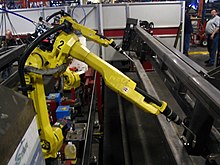考虑 TurtleBot
的手臂调节问题,实现ROS节点,对目标配置实施补偿控制。

Requirement
In this programming task we consider the regulation of the TurtleBot3 arm. The
aim is to implement a ROS node that implements a compensation control
according to a transferred target configuration at the joint level. A PID
controller should be used as the rule specification. Implement the following
functions to control the TurtleBot3 arm in the ArmController class
(arm_controller.cpp, arm_controller.h).
Receive setpoint and joint condition
First, the variables relevant for the regulation must be received via the
corresponding messages. The callback method ArmController :: goalPositionCb
for the target values to be controlled is already defined and assigned to the
message via the subscriber. There you save the received target position from
the transferred message goal_msg (of the type std_msgs :: Float64) into the
variable goal_position_ of the data type std :: map1, with the joint name
joint_name also transferred as the key.
Now expand the constructor with the subscriber joint_state_sub_, which
registers itself on the topic “joint_states” and uses the ArmController ::
jointStateCb method as callback (queue size should be 1). Then, in the
callback method, assign the joint position and speed received via the message
joint_state_msgs (of the type sensor_msgs :: JointState2) to the member
variables current_position_ and current_velocity_.
PID
In the updateJoint () method, implement a PID control for each joint, based on
the current joint positions and speeds. The function receives the joint name
joint_name, the time difference to the last control update delta_time and
writes the current control output in effort_clamped and the current control
error in position_error.
The control parameters are available via the variables p_, i_ and d_ with the
name of the joint currently being viewed as the key. Limit the controller
output to the range [-max_effort_, max_effort_] according to the manipulated
variable limitation. Zero should be assumed as the setpoint for the speed. The
error for the I component should be integrated with the trapezoidal rule. You
can adjust the control parameters via the configuration file “config /
arm_controller_config.yaml” for test purposes.
Anti-windup
In a system with manipulated variable limitation, the windup effect occurs
with the PID controller. Here the position error is still integrated, although
the manipulated variable is in saturation and thus no change at the controller
output results. This can lead to unstable system behavior and strong Cause
overshoot. Therefore, implement the anti-windup strategy known from the
lecture strategy with the gain factor kaw = 1 / ki.
Hints
Start
- Simulation start roslaunch turtlebot3_arm_controller_exercise start_sim.launch
- start the exercise: roslaunch turtlebot3_arm_controller_exercise arm_controller.launch
The Multiplot plugin is loaded in the rqt window that opens (see Figure 1).
For this to be displayed correctly, the display configuration
“arm_joints_data.xml” provided in the “config” folder must be loaded using the
“Open Configuration” button (top right). The absolute path to this file is
stored in the “arm_controller.perspective” which is also in the “config”
folder and can be entered there if necessary.
To perform a movement, the steps marked in Figure 1 must be carried out.
- Resume the paused simulation
- Load the controller to be used by setting the “controller manager ns” with “/ turtle- bot3 / joints / controller_manager “and the controller” arm_trajectory_controller “
- Activate the trajectory calculation
- Start the multiplot
- Now new joint angle specifications can be made using the slider or by entering numbers directly be made.
You can also solve the methods to be implemented using the tests provided
check without using the Turtlebot simulation.
Note: The tests only cover part of the required functionality. Additional
tests and a qualitative evaluation of the plots are used to evaluate the
exercise.
Note: The tests are based on the given PID parameters. Adjusting the PID
parameters will cause the tests to fail.
Build and run the tests: turtle test turtlebot3_arm_controller_exercise
arm_controller.test


